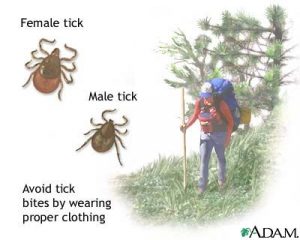Alternate Names : Human monocytic ehrlichiosis, HME, Human granulocytic ehrlichiosis, HGE, Human granulocytic anaplasmosis, HGA
Definition
Ehrlichiosis is an infectious disease transmitted by the bite of a tick.
Overview, Causes, & Risk Factors
Ehrlichiosis is caused by bacteria that belong to the family called Rickettsiae. Rickettsial bacteria cause a number of serious diseases worldwide, including Rocky Mountain spotted fever and typhus. All of these diseases are spread to humans by a tick, flea, or mite bite.
Scientists first described ehrlichiosis in 1990, and have identified two types in the United States:
- Human monocytic ehrlichiosis (HME) is caused by the rickettsial bacteria called Ehrlichia chaffeensis.
- Human granulocytic ehrlichiosis (HGE) is also called human granulocytic anaplasmosis (HGA). It is caused by the rickettsial bacteria called Anaplasma phagocytophilum (once called Ehrlichia equi or Ehrlichia phagocytophila).
Ehrlichia bacteria can be carried by the Lone Star tick, the American dog tick, and the deer tick, which can also cause Lyme disease.
In the United States, HME is found mainly in the southern central states and the Southeast. HGE is found mainly in the Northeast and upper Midwest.
Risk factors for ehrlichiosis include:
- Living near an area with a lot of ticks
- Owning a pet that may bring a tick home
- Walking or playing in high grasses
Pictures & Images
Ehrlichiosis

Ehrlichiosis is a disease transmitted by a tick infected with Ehrlichia organisms. Symptoms include fever, headache and nausea. The disease is treated with antibiotics and recovery is expected.
Antibodies

Antigens are large molecules (usually proteins) on the surface of cells, viruses, fungi, bacteria, and some non-living substances such as toxins, chemicals, drugs, and foreign particles. The immune system recognizes antigens and produces antibodies that destroy substances containing antigens.
-
Ehrlichiosis : Overview, Causes, & Risk Factors
-
Ehrlichiosis : Symptoms & Signs, Diagnosis & Tests
-
Ehrlichiosis : Treatment



Review Date : 9/3/2008
Reviewed By : D. Scott Smith, M.D., MSc, DTM&H, Chief of Infectious Disease & Geographic Medicine, Kaiser Redwood City, CA & Adjunct Assistant Professor, Stanford University.� Review provided by VeriMed Healthcare Network. Also reviewed by David Zieve, MD, MHA, Medical Director, A.D.A.M., Inc.
The information provided herein should not be used during any medical emergency or for the diagnosis or treatment of any medical condition. A licensed medical professional should be consulted for diagnosis and treatment of any and all medical conditions. Call 911 for all medical emergencies. Links to other sites are provided for information only — they do not constitute endorsements of those other sites. © 1997- 2010 A.D.A.M., Inc. Any duplication or distribution of the information contained herein is strictly prohibited.
